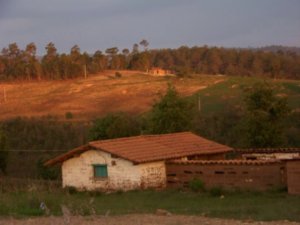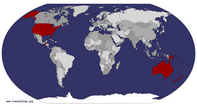Advertisement
Published: June 11th 2008

 Aglow at sunset
Aglow at sunset
Along the road towards Huehuetenango. Note the adobe farmhouse.As I mentioned in our
Semuc Champey entry, we wanted to take a couple more roadtrips before we depart this lovely country. Our final item on the list was a trip out to Todos Santos, way out northwest in the highlands. It's considered fairly remote and isloated, so doesn't get a lot of visitors.
We decided to time the trip with the visit of our friends Carlos and Djuna, who were visiting us from Seattle, as it's always fun to share these roadtrips with friends.
So on Friday afternoon we went, car fully packed, to the kids' school to pick them up and head on out. As Lucas and Grace were getting in the van, Hugo's son Carlos Roberto came by to say goodbye to his dad for the weekend, as we had
hired Hugo to take us on this trip. Carlos Roberto is in the same grade as Lucas, and didn't have any other plans, so of course we invited him to come along to hang out with the kids a little. I joked that he should be our music entertainment, as someone had recently stolen the faceplate off the radio of Hugo's van and we were without his excellent assortment
of music CDs.
Our destination this day was the horse farm of Unicornio Azul, located in the Cuchumatanes mountain range, related to the Sierra Madres. The 6-hour ride had brought us through the outskirts of Huehuetenango, and then up into the high mountain plain called Chancol. By now it was dark and pretty cold - we were at over 9,600 feet in altitude so the air was clear and brisk. There we were met by Paulina, the French equestrian expert and, with her Guatemalan husband Fernando, owner of the rustic but comfortable place. Paulina served us a simple but nice dinner in her lovely farmhouse, which is heated only in the main eating/living area and which made going to our bedrooms a chilling experience. However, once into our beds, Paulina tucked us in under 5 layers of heavy wook blankets and a very hot water bottle, which kept us nice and cozy the whole night long. In fact, Lucas wrapped his pants in the hot water bottle and by morning the pants (and the bottle) were still completely warm.
Morning was bright and relatively warm, so Paulina saddled up the horses and away we all went (Carlos, Djuna,

 Riding up the hils of Chancol
Riding up the hils of Chancol
In the Cuchumatanes mountainsHugo, Carlos Roberto, and us 4 Trautmans), up into the surrounding hills. I wouldn't consider any of us Trautmans big horse fans, but we actually enjoyed this quite a bit. We were able to trot a little, and Carlos taught Lucas how to Boston-Trot, so they couldn't get enough of it. We rode up into some hilly farmlands where the locals make a living off the land. There were farms on plots so steep or craggy that I couldn't believe they could manage it, but Guatemala is the land of hard workers so invariably you could spot someone on a steep hillside, hoeing their fields of corn, potatoes, beans, etc. It was a beautiful ride.
We then left in the van and headed out for the little town of Todos Santos, which again took us through the zig-zaggy dirt roads of the mountains. It took us about 3 hours to go, maybe, 20 miles, because of the rough roads and hair-pin turns going up and down each hill and valley. We could tell we were about to enter the town when we started to see farmers and kids wearing the traditional clothing of Todos Santos, which for the women

 Kids on the farm
Kids on the farm
looking after their sheepis their thick local huipile (woven top) and skirt, and for the men blue striped shirts and red pants. Both men and women (and children) wore round straw hats. This clothing wasn't dress-up time for local tourists (besides ourselves, we saw only 3 other foreigners all day): The clothing of Todos Santos is something they are very proud of, and seek to maintain their culture throughout their future. (During the civil war here, which was brutal for the local population, there was a popular phrase "Our culture is our resistance.") People generally do not marry outside of the local population, so the clothing sticks.
Our lunch was a truly greasy spoon spot where they hadn't seen a gringo in a good while, but the food was typical fare and good. The girls in the kitchen kept coming out to giggle at us. We watched the young men of Todos Santos gather on a terrace above the main street, looking for the few girls that were out on their own. I suppose this is more efficient than cruising in cars. Hugo told us that today was Market Day, so the men would gather together and slowly get drunk and stagger
their way home. Although I found the place fascinating and the mountain scenery beautiful, I also felt a little isolated and cold. Steve, in that smoooooth way of his, called it a sh*thole.
The next morning the kids begged to go horse-riding again, so after breakfast they took an hour ride where they were able to run the horses a little faster than on our mountain hike. It's so ironic that our kids loved the horse-riding, as we have friends in Antigua who run a riding school and have repeately asked if the kids wanted to learn. (And they repeatedly declined.)
Afterwards, we bade farewell to Unicornio Azul and set off to reach the highest non-volcanic point in Guatemala, which was a strategic point for the military during the 36-year civil war (which ended in 1996). The terrain here reminded me a lot of parts of both Norway and Patagonia. Lots of rocks, some scrub and pine trees, and not a lot of oxygen. The roads were pretty rough, and normally Hugo uses his Land Cruiser to manage this, but with our group we had a simple Toyota passenger van, so there were a few exciting moments where

 This is ONE STEEP plot of farmland!
This is ONE STEEP plot of farmland!
Note the red pants of the farmers on the top leftour tires spun on the rocky road and we had to send the kids out to stand on the rear bumper for better traction. At one hill we simply couldn't get up it, so we abandoned the van and started walking. It was pretty cold (especially for Guatemalan standards) and, at just under 10,000 feet, (just under 2 miles high) something of a heart-pumper. I have a photo of the kids running up the trail to the high point and they gave out after about 45 seconds.
Once up at the summit, we stopped to take in the view and to have a little snack of mangos and beer. As we were setting up, I noticed that 3 men with machetes hanging from their belts were making their way towards us. This didn't look good to me; I started some mental scenarios, beginning with us surrendering all our goods and walking a long long ways home, and going all the way to murder and mayhem. I also knew that Hugo carried a gun and that things could
really get interesting. But (of course) as they approached us we got a simple "buenas dias" and within 30 seconds had established
that one of the guys was the brother of a friend of Hugo's. (Of course. Hugo could be in darkest Africa and inevitably someone would emerge with "Hey Hugo!") I wasn't yet convinced, however, so I positioned myself between the men and my kids. Hugo offered them a beer (good tactic, I thought, cloud their judgement with alcohol) but they were more excited about the fresh mangos, which we shared with them.
It turns out these guys are paid to walk up here twice a day and make sure the U.N. weather station is in working order. That done, their work was completed for the day and they seemed fairly amused to see gringos (or anyone else, for that matter) in this spot. We hung out for a little bit, chatting with them and enjoying the beauty and amazing cloud formations off in the distance.
On the route home, we stopped by a small town outside of Huehuetenango called Chiantla, which is not far from the Mexican border and featured more pimped out cars (seriously!) than I'd ever seen in Guatemala. Hugo told us that the culture here is very influenced by Mexico and that he could tell

 Same old story...
Same old story...
...boys looking for girlsat a glance who was who.
Chiantla is known for its history in silver. During the colonial times, the owner of a silver mine commissioned a statue of the Virgin Mary and had it finished in pure silver. The Virgin del Rosario is believed to have mystical healing powers and people come from all over to see her in a small church at the center of town.
The Virgin statue is located in a small glassed-in room behind the altar of the church, and because of its significant value is guarded full-time by faithful volunteers. As we waited in line I noticed the murals on the walls depicting the Mayan workers from the silver mine encountering various miracles attributed to Mary. As we got closer, I could see that the penitents were entering the little room on their knees, then scootching up to the statue and taking a little piece of the veil in their hands as they prayed. After a while they would then scootch away, always keeping their face towards the statue and not letting their backs turn to it.
As we approached the entrance of the room, I was a little concerned about protocol,

 "You can't miss my friend..
"You can't miss my friend..
...he's the one in the red pants."being both a foreigner in this small town and not being Catholic. Hugo assured us that we could stay on our feet, which we did as we entered the room, trying to behave as respectfully as possible as this was clearly a very important icon to the people there.
Once out of Chiantla, we had a big long ride home. I was really happy to see this part of Guatemala; the country feels bigger than it really is (it's about 2/3 the size of the state of Washington) and I feel we've managed to make it to a ton of interesting spots.
Advertisement
Tot: 0.08s; Tpl: 0.014s; cc: 11; qc: 20; dbt: 0.0479s; 1; m:domysql w:travelblog (10.17.0.13); sld: 1;
; mem: 1.1mb




















